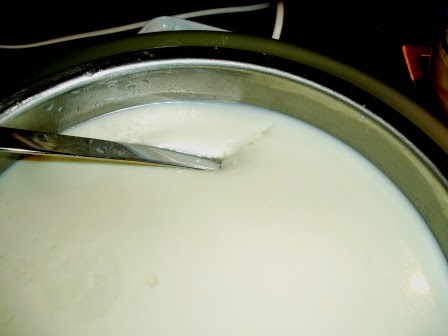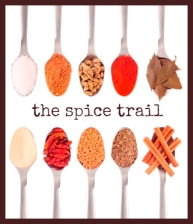I am also trying to put a slight twist on this, in that the focus of my contribution is about making one of Mexico's ingredients, queso fresca. Not a spicy ingredient at all, but one that may be used to temper down chilli heat.
I have been dabbling rather unsuccessfully at making cheese for a year now, but fresh style cheeses are easier and quicker to play with, so this seemed a good opportunity to have another go. I now think my cheese should have been pressed for a short while to get to the more authentic texture but it did produce a well flavoured tub of cheese. The downside was that when baked it turned rather rubbery, so I cannot have produced the exact cheese I was looking for. If you have any thoughts on how to avoid cheese turning to 'rubber' when cooked please comment at the end! None the less I have some tasty soft cheese.
I was using a UK published book by Paul Peacock which may be out of print as the paperback no longer shows on Amazon. However, having looked on the internet there seems to be a very detailed and authentic american recipe for making Mexican queso fresco cheese here: QuesoFresco. There is also an interesting link here for a Mexican Cheese summary from web site epicurious which is based on notes from Mexican cuisine expert Diane Kennedy.
So here is my Mexican Queso Fresco
This cheese needs a culture, either in the form of fresh buttermilk or a starter. I had some starter in my freezer so I used that. By good fortune the rather expensive chocolate melter I purchased a few years ago makes an excellent milk warmer for cheese making. The temperature ranges they both need are similar and both also require gentle heat and accurate temperature control. I can only get 2 litres of milk into this melter so a rather small volume of cheese follows. From 2 litres of milk I ended up with about 450g drained curd. Pressing would have reduced the weight further. I keep the whey and use it for bread or soups, or at worst my chickens have their mash made up with it.
The milk is slowly warmed to 34C before the rennet is added. It is then held at that temperature for an hour.
 |
| Some Useful Tools |
 |
| Cheese 1 hour after Rennet Added |
 |
| Cleaner break after 90 minutes |
 |
| Whey separating readily from the curd |
 |
| Cutting the curd |
 |
| 'Cooked' curd |
The curds are then hung up in a muslin cloth to drain;
Once the whey has stopped dripping you can untie and unwrap!
 |
| Curds after draining in muslin |
So where better to look for a recipe using Mexican cheese than here:
I already had a blade of beef joint slow roasting in the oven flavoured heavily with hot smoked paprika and just needed something to serve with it. What I found was a swiss chard pasta dish and this worked really well even though I have never associated pasta with mexican food before.
So here we have Sopa de Macarron y Acelgas or Macaroni with Swiss Chard to accompany paprika roast blade of beef.
For the 'Mexican' Spice Trail round up pop over to Vanester's blog early in May










What a great idea! I've never tried making my own cheese but I'm rather inspired now to have a go myself. Thanks so much for sharing in The Spice Trail challenge - Destination Mexico :)
ReplyDelete